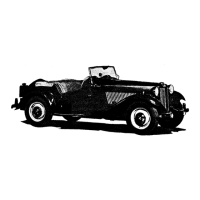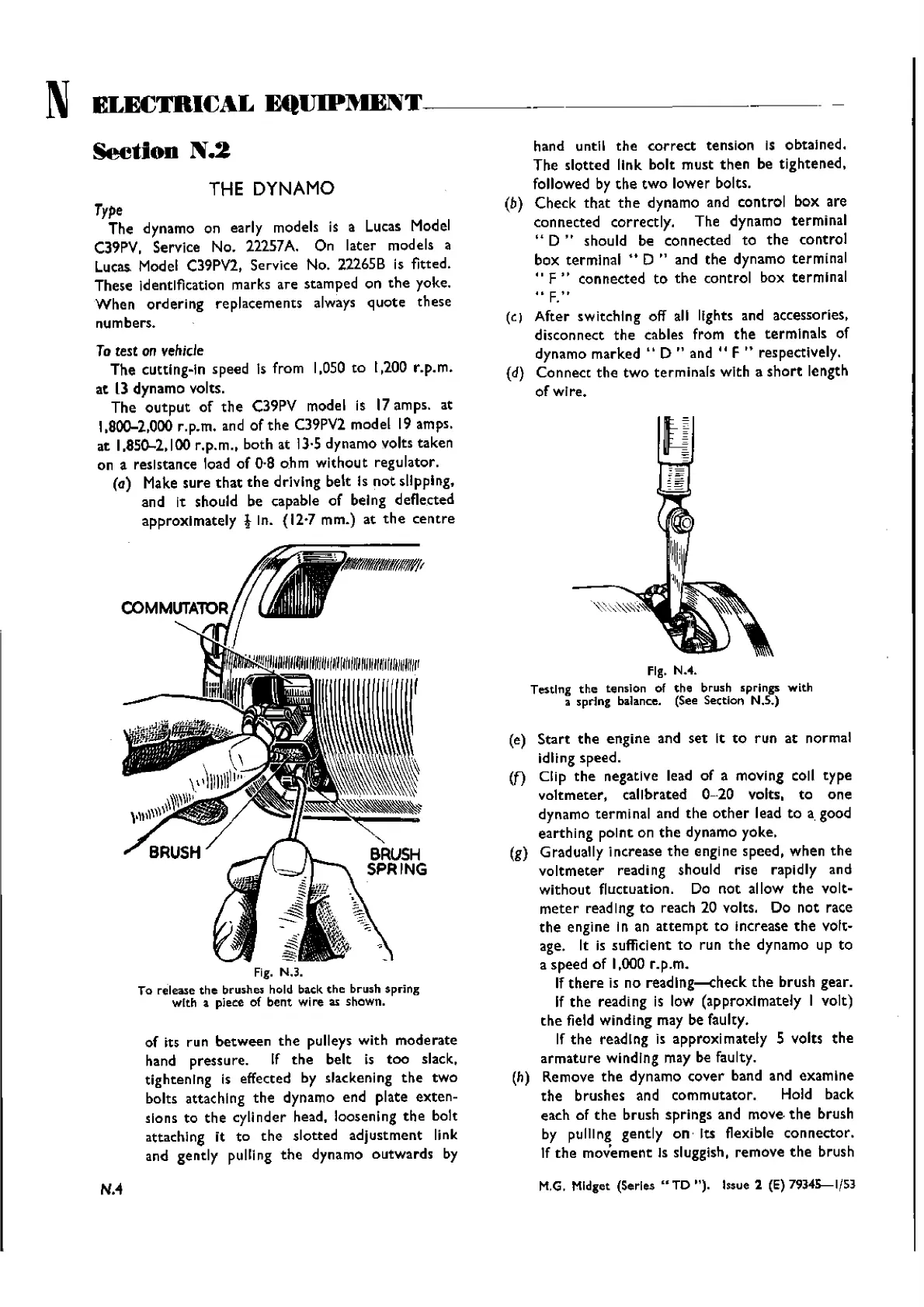N
ELECTRI~AL
EQUIPMENT---
SootieR
N.2
THE DYNAMO
Type
The
dynamo on early models is a Lucas Model
C39PV, Service No.
22257A.
On later models a
Lucas.
Model C39PV2, Service No.
22265B
is fitted.
These identification marks are stamped on
the
yoke.
When
ordering
replacements always
quote
these
numbers.
Totest on
vehicle
The
cutting-In speed is from
1,050
to
t,200 r.p.m.
at
L3
dynamo volts.
The
output
of
the
C39PV model is 17 amps. at
1,800-2,000 r.p.m. and of
the
C39PV2 model 19 amps.
at 1,850-2,100 r.p.m., both at 13·5 dynamo volts taken
on a resistance load of 0·8 ohm
without
regulator.
(0) Make sure
that
the
driving belt Is
not
slipping.
and it should be capable of being deflected
approximately
tin.
(12'7 mm.) at th e
centre
Fig. N.3.
To
release
the
brushes hold back
the
brush spring
with
a piece of
bent
wire
as shown.
of
its
run
between
the
pulleys with
moderate
hand pressure. If
the
belt
is
too
slack,
tightening is effected by slackening
the
two
bolts attaching
the
dynamo end plate
exten-
sions to
the
cylinder head. loosening
the
bolt
attaching it
to
the
slotted
adjustment
link
and gently pulling
the
dynamo
outwards
by
NA
hand until
the
correct
tension is obtained.
The slotted link
bolt
must
then
be
tightened.
followed by
the
two
lower bolts.
(b)
Check
that
the
dynamo and control
box
are
connected correctly. The dynamo
terminal
"
D"
should be connected
to
the
control
box
terminal"
D " and
the
dynamo terminal
..
F"
connected
to
the
control box terminal
(cl After SWitching off all lights and accessories,
disconnect
the
cables from
the
termInals of
dynamo
marked"
0 "
and"
F .. respectively.
(d)
Connect
the
two
terminals with a
short
length
of
wire.
~~
~
fig.
N....
Testing
the
tension of
the
brush springs
with
a spring balance. (See Section N.5.)
(e)
Start
the
engine and
set
It
to
run
at normal
idling speed.
(D Clip
the
negative lead of a moving coil
type
voltmeter.
calibrated 0-·20 volts,
to
one
dynamo terminal and
the
other
lead
to
a good
earthing
point
on
the
dynamo yoke.
(g) Gradually increase
the
engine speed, when
the
voltmeter
reading should rise rapidly and
without
fluctuation. Do
not
allow
the
volt-
meter
reading
to
reach 20 volts. Do
not
race
the
engine In an
attempt
to
increase
the
vote-
age. It is sufficient
to
run
the
dynamo up
to
a speed of
1,000
r.p.m.
If
there
is no
readlng--check
the
brush gear.
If
the
reading is low (approximately I volt)
the
field winding may be faulty.
If
the
reading is approximately 5 volts
the
armature
winding may be faulty.
(h) Remove
the
dynamo
cover
band and examine
the
brushes and
commutator.
Hold back
each of
the
brush springs and
move
the
brush
by puItIng gently
on'
Its
f1exi
ble con nector.
If
the
movement
Is sluggish,
remove
the
brush
M.G. Midget
(Series"
TO
").
Issue
2.
(E)
~34S-I/S3
Wishvilles Classic
Automobile Library

